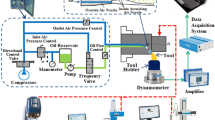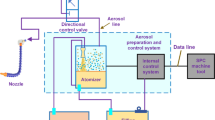Abstract
This paper presents the effect of cutting parameters on the mist particle diameters under the minimum quantity lubrication (MQL) for reducing the air pollution and harm to operators caused by the mist particles produced during the MQL process. In this study, turning experiments were conducted on AISI 304 stainless steel using MQL, for which 16 groups of Taguchi experiments were utilized. The results show that by using the MQL, the contribution rates of the cutting speed and air pressure to the mist particle diameters were 54.62% and 25.34%, respectively. The increase in air pressure caused an increase in the overall proportion of mist particles with diameters in the range of 2.5~10 μm, from 88 up to 96%. The increase in cutting speed aided the conversion of mist particles with a diameter in the range of 2.5~10 μm to a diameter of 2.5 μm, about 16 to 27% of the 2.5~10 μm. However, the overall proportion of the mist particles was not changed. Finally, by targeting the cutting efficiency, surface roughness, and deposition of the cutting fluid mist, the four parameters were optimized using a multi-objective optimization algorithm. Compared to the 14th group experiment with a similar cutting efficiency, the verification experiment results show that the surface roughness decreased 16% and the deposition of cutting fluid mist increased 173% by using the optimized parameters.










Similar content being viewed by others
Data availability
The original data has been included as supplementary materials.
Code availability
Not applicable.
References
Demirbas E, Kobya M (2017) Operating cost and treatment of metalworking fluid wastewater by chemical coagulation and electrocoagulation processes. Process Saf Environ Prot 105:79–90. https://doi.org/10.1016/j.psep.2016.10.013
Kiss A, Fries E (2009) Occurrence of benzotriazoles in the rivers Main, Hengstbach, and Hegbach (Germany). Environ Sci Pollut Res 16(6):702–710. https://doi.org/10.1007/s11356-009-0179-4
Weinert K, Inasaki I, Sutherland JW, Wakabayashi T (2004) Dry machining and minimum quantity lubrication. CIRP Ann Manuf Technol 53(2):511–537. https://doi.org/10.1016/s0007-8506(07)60027-4
Sen B, Mia M, Krolczyk GM, Mandal UK, Mondal SP (2021) Eco-friendly cutting fluids in minimum quantity lubrication assisted machining: a review on the perception of sustainable manufacturing. INT J PR ENG MAN-GT 8(1):249–280. https://doi.org/10.1007/s40684-019-00158-6
Dhar NR, Ahmed MT, Islam S (2007) An experimental investigation on effect of minimum quantity lubrication in machining AISI 1040 steel. Int J Mach Tool Manu 47(5):748–753. https://doi.org/10.1016/j.ijmachtools.2006.09.017
Rahman M, Kumar AS, Salam MU (2002) Experimental evaluation on the effect of minimal quantities of lubricant in milling. Int J Mach Tool Manu 42(5):539–547. https://doi.org/10.1016/s0890-6955(01)00160-2
Ozbek O, Saruhan H (2020) The effect of vibration and cutting zone temperature on surface roughness and tool wear in eco-friendly MQL turning of AISI D2. J Mater Res Technol -Jmr&T 9(3):2762–2772. https://doi.org/10.1016/j.jmrt.2020.01.010
Maruda RW, Legutko S, Krolczyk GM, Raos P (2015) Influence of cooling conditions on the machining process under MQCL and MQL conditions. Tehnicki Vjesnik-Tech Gaz 22(4):965–970. https://doi.org/10.17559/tv-20140919143415
Shah P, Khanna N, Zadafiya K, Bhalodiya M, Maruda RW, Krolczyk GM (2020) In-house development of eco-friendly lubrication techniques (EMQL, nanoparticles plus EMQL and EL) for improving machining performance of 15-5 PHSS. Tribol Int 151. https://doi.org/10.1016/j.triboint.2020.106476
Javidikia M, Sadeghifar M, Songmene V, Jahazi M (2020) Effect of turning environments and parameters on surface integrity of AA6061-T6: experimental analysis, predictive modeling, and multi-criteria optimization. Int J Adv Manuf Technol 110(9-10):2669–2683. https://doi.org/10.1007/s00170-020-06027-w
Ozgoren YO, Cetinkaya S, Saridemir S, Cicek A, Kara F (2013) Artificial neural network based modelling of performance of a beta-type Stirling engine. P I MECH ENG E-J PRO 227(3):166–177. https://doi.org/10.1177/0954408912455763
Eser A, Ayyildiz EA, Ayyildiz M, Kara F (2021, 2021) Artificial intelligence-based surface roughness estimation modelling for milling of AA6061 alloy. Adv Mater Sci Eng. https://doi.org/10.1155/2021/5576600
Ayyildiz EA, Ayyildiz M, Kara F (2021) Optimization of surface roughness in drilling medium-density fiberboard with a parallel robot. Adv Mater Sci Eng 2021:1–8. https://doi.org/10.1155/2021/6658968
Shoshkes M, Banfield WG Jr, Rosenbaum SJ (1950) Distribution, effect and fate of oil aerosol particles retained in the lungs of mice. Arch Ind Hyg Occup Med 1(1):20–35
Thornburg J, Leith D (2000) Size distribution of mist generated during metal machining. Appl Occup Environ Hyg 15(8):618–628
Park K-H, Olortegui-Yume J, Yoon M-C, Kwon P (2010) A study on droplets and their distribution for minimum quantity lubrication (MQL). Int J Mach Tool Manu 50(9):824–833. https://doi.org/10.1016/j.ijmachtools.2010.05.001
Zhao W, He N, Li L, Yang Y, Shi Q (2014) Investigation on the influence of system parameters on ambient air quality in minimum quantity lubrication milling process. J Mech Eng 50(13):184–189
Zhao W, Chen C, He N, Li L, Ren F, Liang X (2015) Effect of milling speed on oil mist concentration in minimum quantity lubrication. Journal of Nanjing University of Aeronautics and Astronautics 47(3):440–445
Lu T, Huang S, Hu X, Feng B, Xu X (2019) Study on aerosol characteristics of electrostatic minimum quantity lubrication and its turning performance. J Mech Eng 55(1):129–138
Lv T, Huang S, Liu E, Ma Y, Xu X (2018) Tribological and machining characteristics of an electrostatic minimum quantity lubrication (EMQL) technology using graphene nano-lubricants as cutting fluids. J Manuf Process 34:225–237. https://doi.org/10.1016/j.jmapro.2018.06.016
Lv T, Xu X, Yu A, Hu X (2021) Oil mist concentration and machining characteristics of SiO2 water-based nano-lubricants in electrostatic minimum quantity lubrication-EMQL milling. J Mater Process Technol 290. https://doi.org/10.1016/j.jmatprotec.2020.116964
Xu XF, Lv T, Luan ZQ, Zhao YY, Wang MH, Hu XD (2019) Capillary penetration mechanism and oil mist concentration of Al2O3 nanoparticle fluids in electrostatic minimum quantity lubrication (EMQL) milling. Int J Adv Manuf Technol 104(5-8):1937–1951. https://doi.org/10.1007/s00170-019-04023-3
Maruda RW, Krolczyk GM, Feldshtein E, Pusavec F, Szydlowski M, Legutko S, Sobczak-Kupiec A (2016) A study on droplets sizes, their distribution and heat exchange for minimum quantity cooling lubrication (MQCL). Int J Mach Tool Manu 100:81–92. https://doi.org/10.1016/j.ijmachtools.2015.10.008
Maruda RW, Feldshtein E, Legutko S, Krolczyk GM (2016) Analysis of contact phenomena and heat exchange in the cutting zone under minimum quantity cooling lubrication conditions. Arab J Sci Eng 41(2):661–668. https://doi.org/10.1007/s13369-015-1726-6
Kara F, Takmaz A (2019) Optimization of cryogenic treatment effects on the surface roughness of cutting tools. Mater Test 61(11):1101–1104. https://doi.org/10.3139/120.111427
Ozturk B, Kara F (2020) Calculation and estimation of surface roughness and energy consumption in milling of 6061 alloy. Adv Mater Sci Eng 2020:1–12. https://doi.org/10.1155/2020/5687951
Kara F, Karabatak M, Ayyildiz M, Nas E (2020) Effect of machinability, microstructure and hardness of deep cryogenic treatment in hard turning of AISI D2 steel with ceramic cutting. J Mater Res Technol -Jmr&T 9(1):969–983. https://doi.org/10.1016/j.jmrt.2019.11.037
Gopal PM, Prakash KS (2018) Minimization of cutting force, temperature and surface roughness through GRA, TOPSIS and Taguchi techniques in end milling of Mg hybrid MMC. Measurement 116:178–192. https://doi.org/10.1016/j.measurement.2017.11.011
Sokolović DS, Höflinger W, Šečerov Sokolović RM, Sokolović SM, Sakulski D (2013) Experimental study of mist generated from metalworking fluids emulsions. J Aerosol Sci 61:70–80. https://doi.org/10.1016/j.jaerosci.2013.03.010
Sarikaya M, Gullu A (2014) Taguchi design and response surface methodology based analysis of machining parameters in CNC turning under MQL. J Clean Prod 65:604–616. https://doi.org/10.1016/j.jclepro.2013.08.040
Zhang D, Pei X (2003) Effects of machining processes on surface roughness and fatigue life. China Mech Eng 14(16):1374–1377
Deb K, Pratap A, Agarwal S, Meyarivan T (2002) A fast and elitist multiobjective genetic algorithm: NSGA-II. IEEE Trans Evol Comput 6(2):182–197. https://doi.org/10.1109/4235.996017
Jensen MT (2003) Reducing the run-time complexity of multiobjective EAs: the NSGA-II and other algorithms. IEEE Trans Evol Comput 7(5):503–515. https://doi.org/10.1109/tevc.2003.817234
Sen B, Mia M, Mandal UK, Dutta B, Mondal SP (2019) Multi-objective optimization for MQL-assisted end milling operation: an intelligent hybrid strategy combining GEP and NTOPSIS. Neural Comput Applic 31(12):8693–8717. https://doi.org/10.1007/s00521-019-04450-z
La Fe PI, Quiza R, Haeseldonckx D, Rivas M (2020) Sustainability-focused multi-objective optimization of a turning process. INT J PR ENG MAN-GT 7(5):1009–1018. https://doi.org/10.1007/s40684-019-00122-4
Dhanalakshmi S, Rameshbabu T (2020) Multi-aspects optimization of process parameters in CNC turning of LM 25 alloy using the taguchi-grey approach. Metals 10(4). https://doi.org/10.3390/met10040453
Chen M-F, Tzeng G-H, Ding CG (2008) Combining fuzzy AHP with MDS in identifying the preference similarity of alternatives. Appl Soft Comput 8(1):110–117. https://doi.org/10.1016/j.asoc.2006.11.007
Diakoulaki D, Mavrotas G, Papayannakis L (1995) Determining objective weights in multiple criteria problems - the critic method. Comput Oper Res 22(7):763–770. https://doi.org/10.1016/0305-0548(94)00059-h
Chen TY, Li CH (2010) Determining objective weights with intuitionistic fuzzy entropy measures: a comparative analysis. Inf Sci 180(21):4207–4222. https://doi.org/10.1016/j.ins.2010.07.009
Chen H (2004) Combination determining weights method for multiple attribute decision making based on maximizing deviations. Syst Eng Electron 26(2):194–197
Acknowledgments
This work was supported by the Sichuan Science and Technology Program (2019YFG0358), a research project of the Chengdu Science and Technology Bureau (2015-NY02-00285-NC), and the Key Technologies Research and Development Program (2020YFB2010500). The authors remain immensely grateful for their support and contribution.
Funding
1. The Sichuan Science and Technology Program (2019YFG0358)
2. Chengdu Science and Technology Bureau (2015-NY02-00285-NC)
3. The Key Technologies Research and Development Program (2020YFB2010500)
Author information
Authors and Affiliations
Contributions
1. The distribution of mist particles of turning AISI 304 under MQL is studied, and the effects of cutting speed, feed rate, depth of cut, and air pressure on the diameters of mist particles are also discussed.
2. The cutting efficiency, surface roughness, and deposition of cutting fluid mist are innovatively taken as an optimization goal.
3. An improved gray relational analysis based on the combined weight is used for searching the best solution to achieve higher cutting efficiency, lower surface roughness, and more deposition of cutting fluid mist.
4. Reducing the emission of mist particles is achieved to protect the environment under MQL.
Corresponding author
Ethics declarations
Conflict of interest
The authors declare no competing interests.
Additional information
Publisher’s note
Springer Nature remains neutral with regard to jurisdictional claims in published maps and institutional affiliations.
Rights and permissions
About this article
Cite this article
Liu, N., Zou, X., Yuan, J. et al. Optimization of MQL turning process considering the distribution and control of cutting fluid mist particles. Int J Adv Manuf Technol 116, 1233–1246 (2021). https://doi.org/10.1007/s00170-021-07480-x
Received:
Accepted:
Published:
Issue Date:
DOI: https://doi.org/10.1007/s00170-021-07480-x




